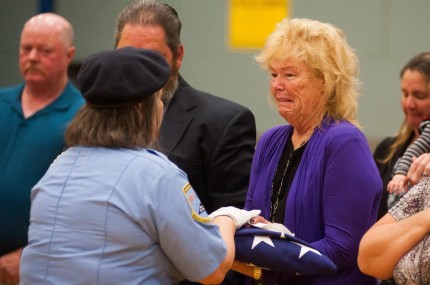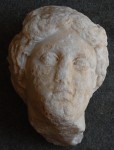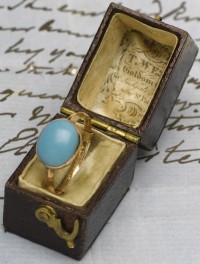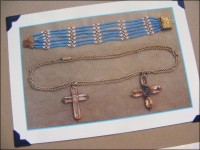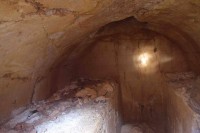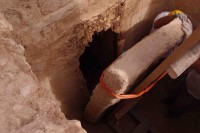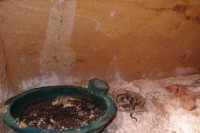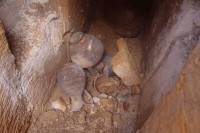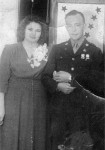 Twelve years ago, Donna Gregory was helping her then-husband go through his deceased grandparents’ home in Arnold, Missouri, when she came across a box in their bedroom closet labelled “War Department.” Inside she found a collection of documents, clippings and medals belonging to Army private first class John Farrell Eddington, including his Bronze Star, Purple Heart, draft card, dog tags, high school diploma and a letter from the War Department notifying the family that Private Eddington was killed in action in Italy on June 27, 1944. He was 25 years old.
Twelve years ago, Donna Gregory was helping her then-husband go through his deceased grandparents’ home in Arnold, Missouri, when she came across a box in their bedroom closet labelled “War Department.” Inside she found a collection of documents, clippings and medals belonging to Army private first class John Farrell Eddington, including his Bronze Star, Purple Heart, draft card, dog tags, high school diploma and a letter from the War Department notifying the family that Private Eddington was killed in action in Italy on June 27, 1944. He was 25 years old.
In the box along with 16 letters he had written to his wife, Helen, there was one particularly moving letter Eddington had written to his infant daughter Peggy three weeks after she was born on February 5th, 1944. He was still training in Texas when he wrote the letter, but before he even got a chance to meet his beloved baby girl, John was deployed overseas. He died four months later, never having held little Peggy in his arms.
Touched and fascinated by the history and emotion inside the box, especially in the letter to baby Peggy, Donna Gregory took it home to St. Louis and researched the soldier off and on for the next dozen years. Gregory’s husband at the time had no idea who Eddington was or what connection he might have had to his grandparents. Eddington was born in Leadwood, Missouri, just 50 miles south of Arnold, but that tenuous geographical proximity is the only commonality we know of. Google and the library led her to some more details about John Eddington. She found that he was buried at the Jefferson Barracks in St Louis. Donna was able to trace Peggy to Nevada, but wasn’t able to find a current address.
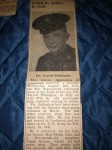 A few months ago Donna picked up the search again, widening the parameters in the hope she could find John Eddington’s daughter before it was too late. She enlisted the help of friends and random Facebook people who read about the story and the crowdsourced effort worked. She found Peggy’s grandson, then she found her son, and then she found Peggy, now Peggy Eddington-Smith of Dayton, Nevada. Donna called Peggy and told her she had her father’s mementos and most poignantly, the letter he wrote her before he died.
A few months ago Donna picked up the search again, widening the parameters in the hope she could find John Eddington’s daughter before it was too late. She enlisted the help of friends and random Facebook people who read about the story and the crowdsourced effort worked. She found Peggy’s grandson, then she found her son, and then she found Peggy, now Peggy Eddington-Smith of Dayton, Nevada. Donna called Peggy and told her she had her father’s mementos and most poignantly, the letter he wrote her before he died.
Peggy was shocked. She knew almost nothing about her father other than that he had died in World War II. Her mother had been so devastated by John’s death that she couldn’t bear to speak of him. Helen never remarried because, as she put it the few times she spoke of him, she had once found the perfect man and would never again find the perfect man.
 To present Peggy with her father’s things in proper style, Donna raised money to travel to Nevada. She also contacted the Nevada Patriot Guard to see if they could put her in touch with a World War II veteran in Dayton or environs so that he could be the one to place the Purple Heart in Peggy’s hands. The Patriot Guard found Navy veteran Quentin McColl, 93, to perform the duty and they organized a motorcycle escort to accompany Donna from Missouri to Nevada.
To present Peggy with her father’s things in proper style, Donna raised money to travel to Nevada. She also contacted the Nevada Patriot Guard to see if they could put her in touch with a World War II veteran in Dayton or environs so that he could be the one to place the Purple Heart in Peggy’s hands. The Patriot Guard found Navy veteran Quentin McColl, 93, to perform the duty and they organized a motorcycle escort to accompany Donna from Missouri to Nevada.
On Saturday, September 21st, Donna Gregory arrived at the Dayton Intermediate School gym. In a ceremony attended by Peggy Eddington-Smith, her family, members of Veterans of Foreign Wars who had fought in World War II, local dignitaries and residents, Peggy received her father’s Purple Heart, Bronze Star, personal documents, replicas of his dog tags, gold star flags and the letters. Donna read the very special letter John Eddington wrote to Peggy aloud before giving it to her.
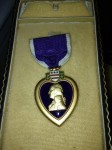 The first page was written to Helen. John hoped she wouldn’t find it “silly” that he was writing to a baby who couldn’t read or understand his words. The next two pages were just pure sweetness from a doting Daddy. I was unable to find a transcript of the entire letter, sadly, but here are bits from various news stories:
The first page was written to Helen. John hoped she wouldn’t find it “silly” that he was writing to a baby who couldn’t read or understand his words. The next two pages were just pure sweetness from a doting Daddy. I was unable to find a transcript of the entire letter, sadly, but here are bits from various news stories:
My Darling Daughter,
You have never seen me or may never see me for some time. I’m sending you this so that you will always know that you have a very proud daddy somewhere in this world fighting for you and our country.
“I love you so much,” the letter said. “Your mother and daddy … are going to give you everything we can. We will always give you all the love we have.”
Eddington urged his daughter to “always treat your mother right. You have the sweetest mother on the Earth.” He closed the letter by writing, “I love you with all my heart and soul forever and forever. Your loving daddy.”
General sobbing ensued. Peggy, who had told reporters before the ceremony she wasn’t going to get “super-emotional,” abandoned that plan.
“The letter gave me more knowledge of who he was,” she told The Associated Press. “He poured out his heart to me, and a lot of men don’t put that kind of emotion in writing. I’m just overwhelmed by everything, trying to absorb everything.”
Then this happened:
Almost everyone in the crowd in the Dayton Intermediate School gym broke down when the VFW commander called roll for members who served in World War II.
Each old soldier shouted “Here sir.” Then he called for Pvt. John F. Eddington. There was silence. He called for Eddington again. A member replied that Private Eddington was killed in action.
Then the shots of a 21-gun salute rang out outside the gym, and taps was played in his memory.
Weep.
